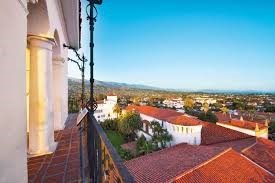THE MOVING TARGET
Part Four

WELCOME TO SANTA TERESA
A strong opening
Macdonald begins his fifth book with an approach he will employ many times—a description of Archer’s surroundings. These descriptions always advance the action and are never just for the sake of grounding the story.
Archer is in a taxi on his way to meet his new client, Elaine Sampson, at her luxurious beachfront home. Where the cab turns off 101, the landscape is scrub oak. They pass a sign as they enter the development, warning that they are on private property and that permission to pass is revocable at any time.
“The scrub oak gave way to ordered palms and Monterey cypress hedges. I caught glimpses of lawns effervescent with sprinklers, deep white porches, roofs of red tile and green copper . . .
The light-blue haze in the lower canyon was like a thin smoke from slowly burning money . . . . Private property: colour guaranteed fast: will not shrink egos. I had never seen the Pacific look so small.”
Elaine Sampson is the first of the many vivid characters Archer meets. She is about 40 and was the mistress of Ralph Sampson before he married her six years before. “She was very lean and brown, tanned so dark that her flesh seemed hard . . . Her age was as hard to tell as the age of a figure carved from mahogany . . . Her toenails and fingernails were painted the same blood color.” She uses a wheelchair, saying that she was paralyzed from the waist down in a horse-riding accident.
She outlines the case to Archer, to use her own description, “bluntly.”
- Her husband Ralph, who is in his middle sixties, is a very wealthy Texas oilman, now retired, with too much time on his hands and a weakness for alcohol and women.
- She cares nothing about either his drinking or womanizing and does not want a divorce; she is determined to outlive him and enjoy the half of his money she would get under his will. (The other half goes to his daughter Miranda.)
- Ralph has disappeared. Although she is not concerned for his safety she is concerned that he will dissipate his money. For example, he recently gave a mountain and hunting lodge to a “holy man” he’d met.
- She wants her husband located discreetly, and, if possible, brought home.
Archer is introduced to Alan Taggert, a big, handsome man in his early twenties who is Ralph Sampson’s private pilot and was the last person to see him before he disappeared.
- Taggert was a fighter pilot in the war. He and Ralph Sampson were close because Taggert reminded Ralph (and everyone else) of Bob Sampson, Ralph’s son, who was also a fighter pilot who died in the war.
- Taggert says that he flew Sampson to LA. While he was parking the plane Sampson called his hotel, the Valerio, where Sampson keeps a bungalow. By the time Taggert was done parking the plane, Sampson was gone. Taggert went by bus to the Valerio to look for him but Sampson was not there and hadn’t been there that day.
Archer also meets Miranda Sampson, about twenty, Ralph’s daughter by a prior marriage.
- Miranda is tall and beautiful, and is besotted with Taggert, who does not return her interest.
- Miranda is being pursued by Albert Graves, about forty, the former District Attorney and now the Sampson family lawyer. Albert Graves recommended Archer for the case.
- Miranda has a poor relationship with her stepmother Elaine.
Archer decides to have Taggert fly him to LA, but first stops at Graves’ office.
- Graves came from an impoverished background and worked hard to support his family and put himself through college and law school.
- He was a diligent DA with political ambitions that did not work out. He left the DA position to begin a lucrative private practice.
- He is desperate for Miranda to marry him.
The chapter ends with Graves accompanying Archer to the waiting car and finds that Miranda has decided to accompany Taggert and Archer to LA:
“’She’s a marvelous kid,” Graves repeated. At forty he was drunk on love.
“He sobered up in a hurry when we reached the car. Miranda was in the back seat with Alan Taggert. ‘I followed you in. I decided to fly down to Los Angeles with you. Hello, Bert.’
‘‘’Hello, Miranda.’
“He gave her a hurt took. She was looking at Taggert. Taggert was looking nowhere in particular. It was a triangle, but not an equilateral one.”
Smooth and professional
Macdonald does everything we can expect in the first twenty pages:
- We know enough to understand the upended nature of the family. Everyone is in mourning for the deceased brother Bob. Ralph has abandoned his responsibilities as head of the family and Elaine has taken leave of her role as a wife. Graves is pursuing a woman almost young enough to be his daughter. Taggert is restless and self-absorbed, wishing he was back in the war.
- Even if we hadn’t read Macdonald’s four previous books, Archer’s observations make it clear that he is not impressed with the wealth on display. The problems created by money will be a theme not only of this book, but of most of the books in the series.
- Miranda thinks Elaine is faking her paralysis. We never learn the truth, but the belief that a person in the prime of life would pretend to be an invalid tells us a great deal about the person making the accusation. One or the other of them is a twisted person. Maybe both. Macdonald just drops this into the pot without ever resolving it. A wise move, I think.
- Although we will meet plenty of people in the course of the book, we have already met everyone who is central to the solution.
Recent Comments